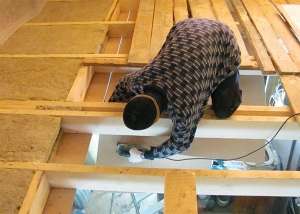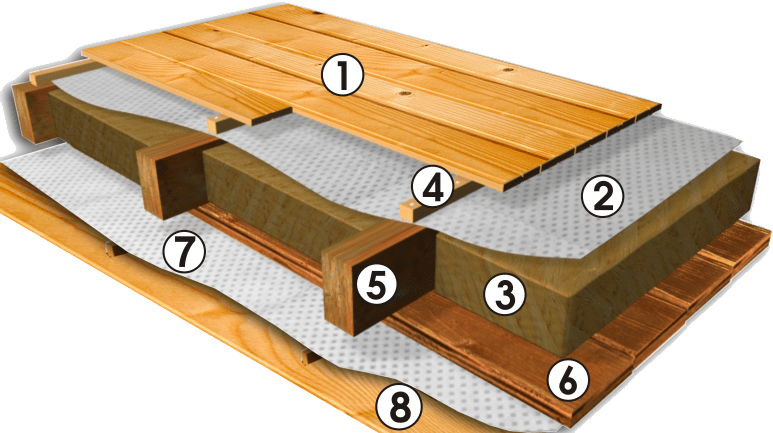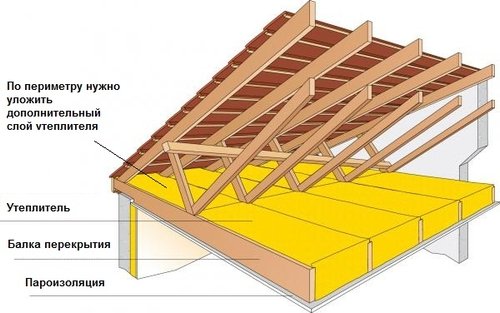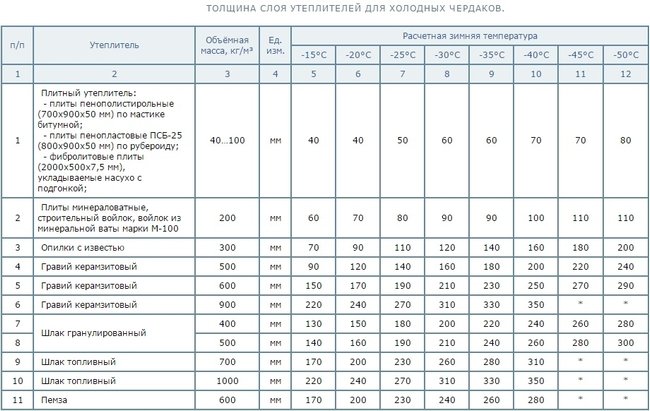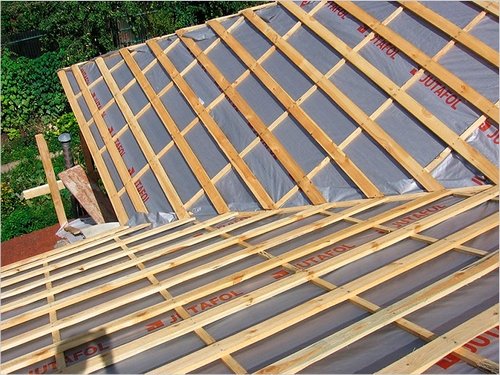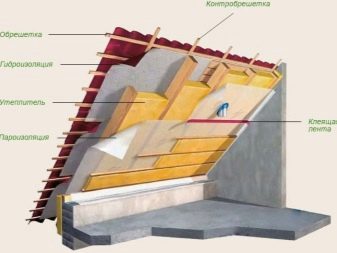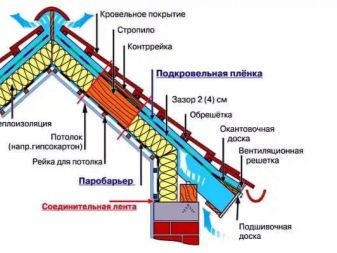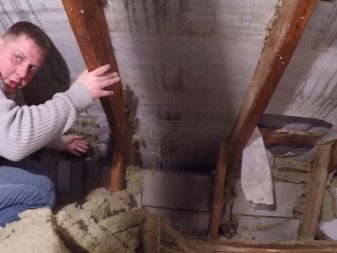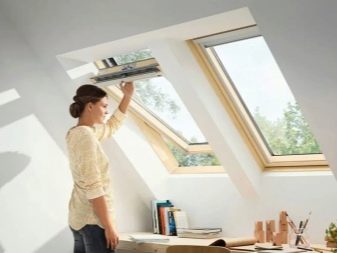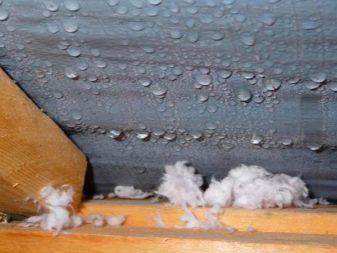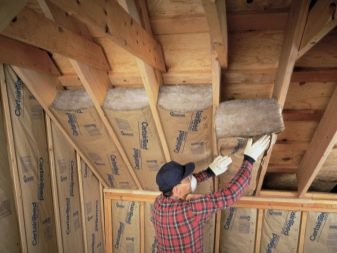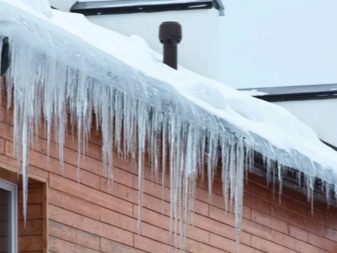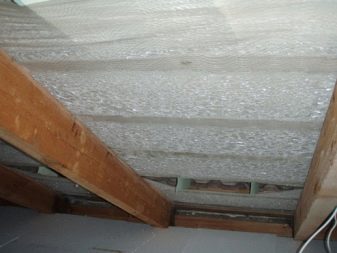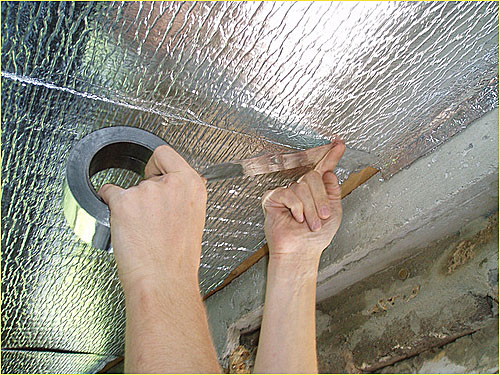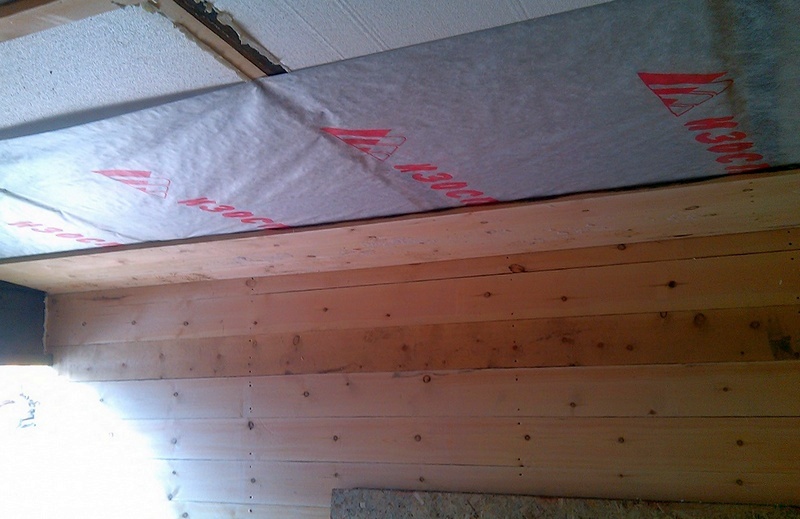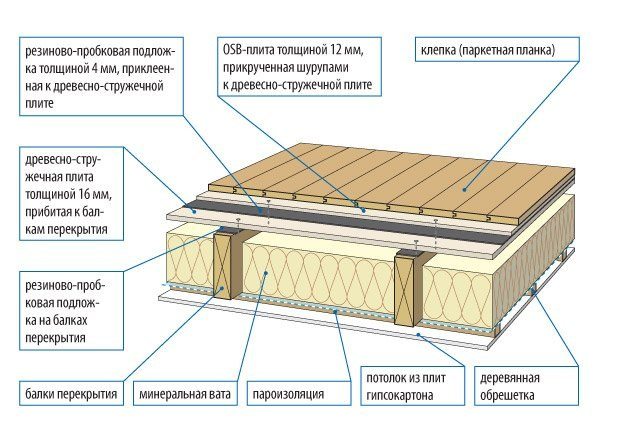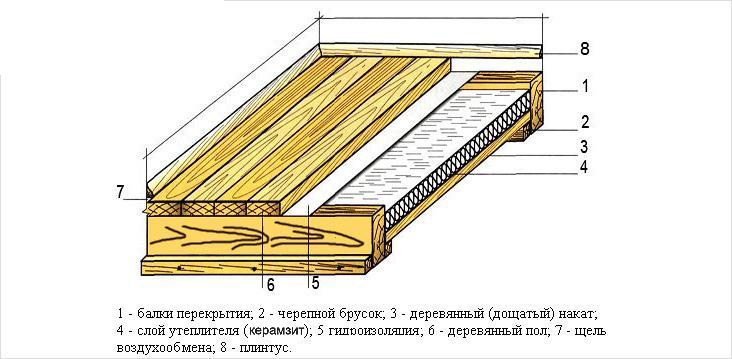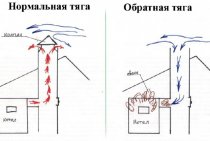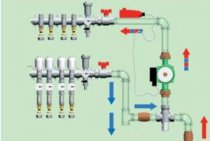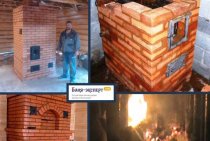2 Why mineral wool is used to insulate the attic
In most cases, when insulating attic floors, the choice of the consumer falls on mineral wool. Its advantage lies in the fact that its installation does not require special skills.
Mineral wool has excellent thermal insulation properties. Its structure consists of thin vitreous fibers, the length of which ranges from 2 to 60 millimeters.
Attic insulation with mineral wool
High soundproofing characteristics are provided due to the presence of a large number of air pores.
These pores are located in the space between the fibers and can occupy 95% of the total volume of the insulation. Mineral wool is presented in three varieties, it can be basalt glass and stone.
Basalt wool is made using molten basalt rocks, to which binders are added.
2.1 Technology of insulation of attic floors with mineral wool
During work related to mineral wool, it is important to comply with all safety requirements and regulations. This is due to the fact that in the process of cutting and laying such material, the air is filled with tiny particles that can enter the respiratory organs and thus cause harm to human health.
This is due to the fact that in the process of cutting and laying such material, the air is filled with tiny particles that can enter the respiratory organs and thus cause harm to human health.
When carrying out installation, be sure to take care of the availability of personal protective equipment. Goggles, a respirator and thick rubber gloves should be available.
The process of warming attic floors begins with the selection of the necessary tools and additional materials. Can't do without:
The essence of the insulation technology lies in the fact that the insulation must be carefully laid in the space between attic floors or beams.
To enhance the thermal insulation qualities, reliable vapor barrier should be used. Warm and moisture-saturated air will continuously rise from the living rooms and go up through the ceiling.
There, in the roof space, he will collide with a layer of insulation. Due to the fact that mineral wool is generally considered to be a vapor-tight material, it will take all the outgoing moisture into itself.
If it is left without the necessary access of air and sunlight, it will gradually shrink and, in the end, will lose all its heat-insulating qualities.
Attic cold interfloor overlapping 20 cm min.
In order to avoid such destructive consequences, it is necessary to lay a vapor barrier material under a layer of mineral wool.
Before starting the main work, it will be necessary to carefully calculate the required amount of insulation.
To do this, it is necessary to calculate the total area of the entire surface of the attic space, and then purchase the highest quality and most reliable insulation, which must meet all the necessary requirements.
Why is ceiling vapor barrier necessary?
Rockwool ceiling vapor barrier is a great way to protect and extend the life of a hardwood floor, which:
- significantly extends its service life, eliminating rotting from the inside and deformation of building materials;
- increases the percentage of heat stored by the ceiling in the room;
- makes the attic an inaccessible place for the formation of mold and mildew.
In addition, it is worth paying attention to the absolute absence of the need for further additional maintenance of vapor barrier materials,taking into account their composition and the structure of the entire floor structure. Therefore, by pulling during the initial construction, or during the repair, the vapor barrier of the steam room ceiling, in the future you can not worry about possible problems.
Vapor barrier for attic pie
- Attic floor (ladders) - necessary for maintenance, repair of the roof and attic space. In order to get to the attic, provide an attic staircase with an insulated hatch (Thermo). To exit from the attic to the roof, we recommend installing deaf or glazed exit hatches on the roof (Velux, Vilpe, etc.)
- Para- or super-diffusion moisture-proof membrane - for the effective removal of steam from the insulation.
- Insulation - mineral wool boards. The recommended thickness for the Moscow and Leningrad regions is 300mm. 200 mm are laid in the inter-beam space, the remaining 100 mm are laid perpendicular to the laid layers - counter-warming. For comparison, building codes in Finland determine the thickness of the insulation from 400 to 500 mm. It is recommended to postpone the laying of the insulation as much as possible - not earlier than 6 months after the completion of the construction of the house box. Because for the construction of the floor, mainly a bar of natural moisture is used. The beam must dry properly, otherwise there is a high probability of wood damage by fungi and mold, which entails additional costs for dismantling / installation work and wood treatment with bleaches and antiseptics.
- Control grille and ventilated gap. For effective ventilation and removal of steam from the surface of the waterproof membrane.
- Cover beams. As a rule, in private housing construction, a board 50x200mm or a bar of natural moisture 100x200mm is used.
- The crate is the basis for laying the insulation. As a crate, it is recommended to use a board 100x20 (25) mm and lay it in 70-80 mm increments. The resulting cracks will form an additional air thermal layer under the insulation. That. Insulation plates (mats) will not lie on a vapor barrier film, but on a rigid base, already under which there will be a vapor barrier. This solution eliminates the possibility of accidental damage to the vapor barrier or its punching when laying insulation, during maintenance and repair work of the roof and attic. In this case, you can proceed to the interior decoration of the premises, and postpone the installation of the insulation as much as possible (see above).
-
Attic vapor barrier on wooden beams
- fastened with a construction stapler from below to the draft ceiling (crate), which allows you to cut off the pairs from the entire floor structure. It is necessary to overlap the vapor barrier rolls at least 15-20 cm and carefully glue them with aluminum adhesive tape. Be sure to form laps on the walls of 15-20 cm and carefully glue them (start under plaster and other wall decoration). Carefully seal the places where chimneys, ventilation pipes and other utilities pass through the attic floor using special sleeves. The best vapor barrier material is high-density polyethylene film from 200g/m² and above. - Close attic - the finished ceiling is attached to the vapor barrier
. On the crate, guides, the final ceiling is installed (OSB, drywall, etc.). For the best fire protection, it is recommended to “sew up” the ceiling with drywall sheets in 2 layers.
Benefits of a cold attic
The advantages of choosing a cold attic is that:
-
Waterproofing is much more reliable. The fact is that when creating a warm attic structure, the integrity of the rolled waterproofing is in any case interrupted by superstructures, which significantly reduces its reliability. In the design of a cold attic, add-ons should be kept to a minimum.
-
Maintenance becomes as simple as possible.An attic is an attic and often something needs to be corrected or replaced, which with such a design is as easy as shelling pears. There is a lot of space, cold attic maintenance is convenient and practical.
-
The heat transfer surface area is minimal. With this design, there is only minimal heat loss from those rooms that are located directly under the attic.
-
Possibility of exploitation. As mentioned above, such an attic can be easily adapted both for a warehouse and for other needs of the owners. Depending on the method of getting into the attic, whether it is a ceiling hatch from a dwelling, or a door from the street, even fodder supplies can be stored on it, if we are talking about a rural house.
What kind of film to put under the insulation in the attic All about insulation and energy efficiency
When providing insulation of a private house and insulation of the roof along the rafters, one must not forget that special attention should be paid to such a place as the attic. Development of attic floor insulation with mineral wool
Development of attic floor insulation with mineral wool
Warm air tends to rise to the top, and therefore, in a temporarily unheated room, heat can escape through the space of a cold attic. Therefore, the issue of attic insulation must be addressed without delay.
1 Why is attic floor insulation necessary?
Insulation of the cold floor of the attic with stone or mineral wool, by and large, is necessary in little used premises, which are properly equipped with special roof ventilation.
The attic, or rather its ceilings, perform the function of a kind of boundary between heat and cold. In such places, attic floors are exposed to intense moisture due to the formation of condensate.
However, it is possible to properly insulate the floors in the attic of the house with mineral wool with your own hands. The very process of insulating the floor in the attic with mineral wool is the creation of a durable thermal insulation coating, which will have a low degree of thermal conductivity.
The very technology of mineral wool insulation of floors in the attic, as well as Energoflex thermal insulation for pipes, implies strict adherence to its stages and requirements.
By itself, this technology is quite simple and understandable. Good thermal insulation of the attic floor with mineral wool helps to close unwanted gaps.
To do this, the insulation must be laid tightly. In most cases, mineral wool is used to insulate the attic of a house.
The presented insulation is the most suitable for this type of work, it can also be used to insulate the floor surface in the living quarters of the house.
Schematic insulation of the attic floor with mineral wool
With the organization of good insulation with mineral wool, the most optimal temperature will be maintained in the living quarters.
If the procedure is not performed correctly, then moisture rising from the floor of the house will lead to the formation of condensate.
It will accumulate on the ceiling, and then seep through the floors. The resulting temperature difference in those areas where attic floors adjoin the walls of the house initiates the formation of mold and microscopic fungi, which can be the causative agents of allergic diseases.
1.1 Attic insulation requirements
The process of insulating the floor of the attic and insulating the roof of the house with your own hands, or rather the level of its quality, has a direct impact not only on the size of heat loss, but also on the duration of the operational life of the entire truss structure and roofing.
The fact is that the water vapor inside the heated room diffuses to the attic of the house. In order for the applied insulation to provide a high degree of calculated efficiency of the heat-insulating layer, it must always be dry.
Based on this, the insulation must be protected from excessive moisture by vapors of ascending heated air using a special vapor-tight material.
Steam and thermal insulation of a cold attic
For a roof with a cold attic, it is most important to minimize heat loss through the attic floor. For both wooden and reinforced concrete floors, vapor barrier is mandatory.
It is laid on the ceiling itself and protects the insulation from vapors that can condense in the heat insulator, passing through the ceiling of the living space. As a heater, plate and bulk materials can be used. The ceiling pie consists of a vapor barrier, floor beams and insulation.
The following types of heat insulators are often used in ceiling ceilings:
- polystyrene and foam boards;
- mineral wool boards or mats;
- expanded clay granules;
- fuel or granulated slag;
- sawdust with lime or clay;
- pumice.
The thickness of the required insulation layer is selected depending on the calculated winter temperature using the table below.
Winter temperature is calculated according to SNiP 2.01.01-82 (construction climatology and geophysics) or is selected by regions of the Russian Federation from the corresponding climate maps.
Insulation is placed between the joists or beams of the ceiling, and a plank flooring is made on top for attic passages. Logs are usually 50 mm thick, and deck boards are 25-35 mm thick.
Attic waterproofing device
Waterproofing roofs with a cold attic, according to many experts, is a controversial issue. Some say that waterproofing must be present under the roofing material, and someone categorically recommends that it be abandoned. Much here depends on the type of roofing material and the angle of inclination of the roof slopes.
Metal roofs are most susceptible to corrosion, which occurs with possible small leaks or from condensation.
Therefore, once again we draw your attention to the fact that ventilation plays one of the main roles in the fight against condensate.
For flat metal roofs, experts recommend installing superdiffusion membranes. It will prevent moisture from entering the outside of the roof when blowing snow or rain. No matter how well the roof is laid, there is always the possibility of minimal leaks. That is why, having overpaid a little, you will receive additional protection against moisture ingress on the insulation in the ceiling of a cold attic.
If, for example, slate is used as a roofing material, then waterproofing can be abandoned. There is also a corrugated board with an anti-condensation coating on the market, which can hold up to 1 liter of water per 1 m2. For our part, we recommend that you always use waterproofing membranes, because this is the cheapest and easiest additional way to protect your roof from possible leaks..
When installing waterproofing membranes, a counter-lattice is used. It performs the function of a fixing rail and, due to its height, provides the necessary clearance for ventilation of the under-roof space. The device of the crate of a cold attic is no different from insulated roofs. The dimensions of the crate and its pitch determine the type of roofing to be installed.
Temperature regime of a cold attic
To prevent ice and icicles from forming on the roof, it is necessary to maintain the correct temperature and humidity conditions in the attic. With insufficient thickness of the heat-insulating material, significant heat losses occur through the ceiling. Warm air, heating the roofing, causes snow to melt and ice to form. By choosing the right layer of insulation, this can be avoided.
You can evaluate the effectiveness of a heat insulator using a temperature measurement of the top layer of insulation.An electronic thermometer is immersed in a heater by 10-20 mm. The temperature readings taken must match the values in the table below.
As you can see, the arrangement of a cold attic pie does not differ in particular constructive complexity. The main task is to provide the necessary intensity of ventilation and the thickness of the heat-insulating layer in the ceiling.
We will carry out the installation of a copper roof quickly and efficiently
Peculiarities
Most of the warm air masses escape through the roof. Therefore, when building a house with an uninsulated attic, you need to carefully approach the topic of insulating an attic floor with wooden beams. After all, it creates a certain barrier between warm rooms and a cold attic.
Consider the special criteria for attic thermal insulation that affect the preservation of temperature in the house:
-
The purpose of the room.
The attic is a kind of buffer between the environment and the habitable rooms. Its task is to regulate the temperature difference between the external environment and the house. -
Temperature regime.
In any season and any day, the temperature of the air masses in the attic will always be higher than outside the window. That is why it is very cold in the attic in winter, and unbearably hot and stuffy in summer. -
Heat loss in winter.
The more a substance is heated, the less dense it becomes. This is a physical phenomenon. That is why in residential premises with a heating system, warm air from household appliances is concentrated in the ceiling area. That is, if you do not insulate the ceiling, then in winter all the warm air will warm the attic.
-
Too much heat in summer.
In summer, the reverse process can be observed. The roof heated by the rays of the sun will heat the attic air, which, in turn, will penetrate into the room through the attic floors. -
Reverse circulation of air masses.
In contact with the ceiling without thermal insulation, warm air becomes colder, denser and, as a result, descends to the floor. This is reflected in the living room in the form of walking drafts, which are harmful to human health.
-
The appearance of excess moisture.
In contact with an uninsulated attic, humid hot air turns into condensate. The overall level of humidity in the house increases, which leads to the formation of mold pockets in the corners. -
Saving
. The heat that has gone through the roof without insulation is about 30%. This means that with proper attic insulation, you can save 30% of the fuel used. The use of air conditioning in the summer will also be associated with lower costs.
The ingress of warm air masses into a technical attic (non-residential) leads to negative consequences:
- Due to the mixing of warm and cold masses, condensation may appear in the attic. Water entering the surface can lead to wood decay processes on the supporting beams.
- If it is warm in the attic, then the snow that has collected on the roof will begin to melt. The water dripping at the same time will begin to turn into icicles. Frost forms on the drainage system.
Vapor barrier membranes
Diffuse (breathing) membranes are classified as the most effective and expensive vapor barriers. In this group of goods there are both single-sided and double-sided materials.
The former allow steam to pass in only one direction, so during installation it is extremely important not to confuse which side to lay the canvas to the insulation, and which side to the bearing surface. Double-sided work in both directions, so there are no problems with them

Vapor barrier membranes are single-layer and multi-layer. The first are affordable. Multilayer have the function of accumulating moisture inside the canvas and its gradual return.
A special group of products in this category is "intelligent" membranes.They are able not only to absorb vapors, but also to regulate the level of humidity of the surrounding materials, while acting as a hydro-barrier. These membranes are the best choice. But their cost is beyond the reach of most owners of private houses.
Vapor barrier membranes "TechnoNIKOL"
The undoubted leader in this category of materials is TechnoNikol membranes. For the vapor barrier of the ceiling of wooden floors, the Optima brand is recommended for use. This hydrophobic polypropylene membrane consists of three layers:
- upper and lower polypropylene;
- medium - high-tech functional vapor-permeable film.
- weight 80 g/m2;
- thickness 0.3 mm;
- vapor permeability 5 g/m2x24 hours.
The membrane "TechnoNICOL Optima" is produced in rolls. The width of the canvas (roll height) is 1.5 m. The length is 50 m. This material is optimal for vapor barrier of any type of ceiling, designed for installation indoors and on the external surfaces of buildings.

Reinforced superdiffuse membrane


Diffusion membrane films "TechnoNikol"
Rules for installing a vapor barrier for a wooden ceiling
Step 1. The membrane is laid directly on the insulation so that the smooth side is directed into the room.
Step 2. It is possible to lay the strips in different directions: parallel or perpendicular to each other.
Step 3. During installation, an overlap of at least 10 cm must be observed.
Step 4. To fix the membrane to a wooden floor without insulation, use galvanized self-tapping screws with wide hats or brackets with an anti-corrosion coating.
Step 5. The joints of the canvases are sealed with self-adhesive mounting tape.
Use foil tape, width 50 mm, length 30 running meters.
Step 6. When laying on a floor with insulation, it is necessary to bring the edges of the canvases to the wall by 15-20 cm and fix them with suitable materials (battens or metal profiles).
Step 7 Mounting tape is glued around the perimeter of the vapor barrier layer.
Step 8 Between the membrane and the material with which the wooden floor will be lined, leave a ventilation gap 3-4 cm wide.
Step 9 Particular attention should be paid to the points of contact of the vapor barrier with the structural elements of the floor and the building: beams, chimneys, ventilation ducts.
Vapor barrier of the ceiling in a wooden ceiling
During the installation of the vapor barrier, it is necessary to ensure that the film is laid evenly, without wrinkles or sagging. A guideline for proper installation can be a colored strip, which is the central line along the entire length of the canvas.
Video - Ceiling vapor barrier
Other brands of multilayer vapor barrier membranes are also a good choice: Dorken Delta REFLEX / REFLEX PLUS and Dorken Delta LUXX. The first is a four-layer material, is particularly durable and is able to provide 100% waterproofing of a wooden floor. The second has a limited vapor permeability, providing a gradual and uniform removal of moisture from the living space.
floor structure
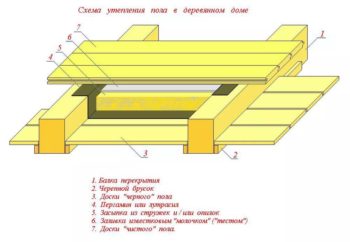
Before proceeding to a detailed description of the creation of the correct "pie" of the floor of the first floor, it is worth noting the constituent elements and technical rules.
- Priming. The overlap of the first floor separates the room from the underground space, the surface of which is soil. The soil becomes a source of moisture ingress into wood structures, which can adversely affect their technical properties. Therefore, this surface must be waterproofed. On the second floor, waterproofing is not necessary.
- Ventilation must be carried out in the underground space so that moisture penetrating from the ground is weathered and does not get into the floor ceiling.
- Brick pillars on which wooden floor beams lie.
- Wooden beams.The beams serve as a supporting element for the floor joists. Depending on the step with which the beams are laid, the choice of the thickness of the boards for the supports depends. The design should easily transfer possible loads without deformation of the floor.
- Logs - transverse boards lying on the end sides. They serve as the basis for laying the finished floor in the form of floor boards or using plywood or other tile substrate.
- Insulation material is filled between the bars. In this case, it is necessary to take into account that there is a gap between the insulation and the finished floor for ventilation.
- Vapor barrier and waterproofing to protect the insulation material from moisture ingress.
- Finished floor with or without sheet and tile backing. When using boards, they are laid on the bars, and such finishing coatings as laminate, parquet, tiles are placed on a leveling layer of tiled material.
When using an insulated coating, it is necessary to take care of damping gaps for ventilation under the floor.
The choice of insulation
The methods of insulating the ceiling of the upper floor of the ceiling along the beams in a private house are very diverse. When doing do-it-yourself work, the insulation is placed between the lags and provides reliable thermal insulation and noise protection.
There are many options for insulating the structure, the most common of them are:
- mineral wool insulation;
- laying on wooden beams of expanded polystyrene (polystyrene or foam plastic);
- backfilling with expanded clay;
- sawdust insulation;
- filling the ceiling space with foam.
Each of these options has its own characteristics and advantages.
Mineral wool insulation
The material is produced in two versions: plates and rolls. Thermal insulation of the attic floor with mineral wool has the following advantages:
Styrofoam


Styrofoam has become one of the most common materials for thermal insulation. He deserved a place in the top three thanks to a very attractive price. The use of this insulation in an individual house provides the following advantages:
- high degree of protection;
- resistance to decay and the occurrence of mold and fungus;
- low degree of water absorption;
- ease of installation and no need for complex tools and protective equipment;
- the light weight of the material does not allow excessive load on the structures and allows for insulation from below.
Extruded polystyrene foam
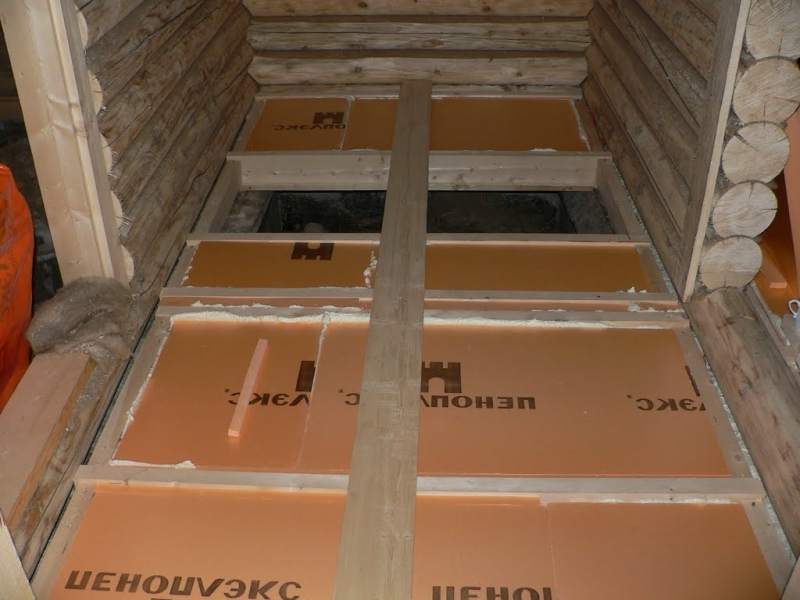
Do-it-yourself installation is quite simple. This issue is discussed in detail in the article. The text discusses the use of both foam and foam plastic for different types of floor construction.
For people who decide to build their own wooden house, the naturalness of the materials is usually important. Here, penoplex, like polystyrene, loses to other types of insulation due to artificial origin.
Expanded clay or sawdust
If you decide to use completely natural materials in the house, these two types of insulation will become indispensable helpers. They do not have high heat-shielding characteristics, like the previous types, but provide reliable protection from the cold with a sufficient layer thickness.
Sawdust can be obtained almost free of charge, expanded clay is also an inexpensive material.
Insulation of the attic floor can be carried out by non-professionals and does not require special skills. The limitation of the application is the physical features of these materials: they cannot be used for thermal protection from below.
Foam for thermal protection

Polyurethane foam insulation is a fairly new material in construction. With the independent construction of the building, this method can provide high speed work and reliable protection from the cold. You can read about the insulation of the building, including attic floors, with foam in the article.
This provides a large selection of materials for insulation and significantly save on construction.
A large percentage of heat loss occurs precisely through the overlap of the upper floor, so it is so important to choose the right insulation and follow the laying technology. Are you insulating your house for the winter and don't know how to insulate the attic floor along the wooden load-bearing beams? Having gained experience in this matter, I will accurately convey the technical aspects of thermal insulation, and also describe step by step the procedure for carrying out the work.
Are you insulating your house for the winter and don't know how to insulate the attic floor along the wooden load-bearing beams? Having gained experience in this matter, I will accurately convey the technical aspects of thermal insulation, and also describe step by step the procedure for carrying out the work.
